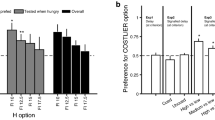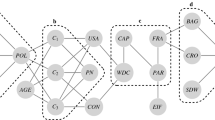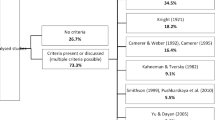Abstract
Choice modellers are frequently criticized for failing to provide accurate representations of the neuro-psychological substrates of decisions. Several authors maintain that recent neuro-psychological findings enable choice modellers to overcome this alleged shortcoming. Some advocate a realistic interpretation of neuro-psychological models of choice, according to which these models posit sub-personal entities with specific neuro-psychological counterparts and characterize those entities accurately. In this article, I articulate and defend three complementary arguments to demonstrate that, contrary to emerging consensus, even the best available neuro-psychological models of choice cannot be justifiably given this realistic interpretation. Moreover, I explicate what challenges will continue to hamper neuro-psychological modellers’ attempts to substantiate a realistic interpretation of their models. In doing so, I draw on the literature on scientific modelling to advance the ongoing philosophical discussion concerning the ontological status of the sub-personal entities posited in distinct decision sciences, the resemblance relations that supposedly connect choice models and the neuro-psychological substrates of decisions, and what conditions these models must satisfy to be regarded as realistic representations of their target systems.
Similar content being viewed by others
Notes
I shall speak of neuro-psychological models broadly so as to include neuroeconomic models in this category. Over the last decade, different approaches to neuroeconomic modelling have been developed (see e.g. Fumagalli 2010, 2015). I shall comment on these approaches in various places throughout the paper. For now, it suffices to observe that my critique bears on both ‘behavioral economics in the scanner’ and ‘neurocellular economics’ (Ross 2008a), but does not extend to works that do not presuppose the realistic interpretation I target (see e.g. Harrison and Ross 2010).
Similar categorizations have been proposed in specific decision sciences. For instance, Mäki (1992, 329) defines idealizing assumptions in economic theory as: referentially realistic when they can be taken to refer to non-fictitious target systems; representationally realistic when they represent features that are actually possessed by their target systems; and veristically realistic when they characterize these features accurately. Adopting Mäki’s terminology, the proponents of the realistic interpretation of neuro-psychological models of choice may be said to regard these models as referentially, representationally and veristically realistic representations of the neuro-psychological substrates of decisions.
Some authors take the contrast between economic and neuro-psychological models of choice to be even more profound than what I suggest. For instance, Ross et al. (2008, viii) claim that standard economic models do not rest on specific assumptions as to what sort of entities (e.g. individuals, firms, countries) representative agents supposedly map onto. In their view, the agents posited by economic models are representative optimizers whose ontological status is indeterminate. I do not assess these claims here, as my contrast between realistic and other interpretations of choice models holds irrespective of their cogency.
In this article, I examine a wide array of sub-personal posits, ranging from individual neurons to neuro-psychological processes, cognitive modules and multiple selves. My three challenges do not have equivalent implications for models that postulate distinct kinds of posits. However, even the best available neuro-psychological models fail to meet at least some of my three challenges (see Sections 3–5).
Similar concerns arise regarding other entrenched neuro-psychological categorizations (see e.g. Gigerenzer and Regier 1996, on the divide between associative and rule-based systems proposed by Sloman 1996; see also Evans 2008, on the distinction between intuitive and reflective judgments made by Kahneman and Frederick 2002).
Analogous remarks apply to other controversies in neuro-psychology. By way of illustration, consider the debate concerning the alleged existence of systematic mappings between cognitive functions and brain structures. Once precise definitions of cognitive function and brain structure are provided, there will presumably be some fact of the matter as to what kinds of mappings hold between these relata. Unfortunately, attempts to settle these issues have been plagued by widespread ambiguities in the use of those notions (see e.g. Price and Friston 2005).
I gloss over additional criticisms of the statistical manipulations and corrections implemented in neuro-psychological studies, since these criticisms are already well advanced in the specialized disciplinary literatures (see e.g. Harrison 2008, on the propagation of standard errors of estimates in neuroeconomic studies, and Vul et al. 2009, on endemically inflated correlations in social neuroscience articles).
The notion of stimulus underlying the distinction between ‘stimulus-bound’ rewards and ‘non-stimulus-bound’ choice alternatives is amenable to further analysis. In the text, I speak of stimuli that involve perceptual contact with actual or imaginary triggers to reflect how reward valuation tasks are typically operationalized in neuro-psychological research.
For example, some (e.g. Schelling 1978) represent agents’ behaviour as the solution of a bargaining game among several competing sub-agents. For their part, others (e.g. Benabou and Tirole 2003) model decisions as the sequential equilibrium of a signaling game between multiple selves, each controlling the agent’s behaviour during distinct temporal intervals.
References
Ainslie, G. (1992). Picoeconomics: The Strategic Interaction of Successive Motivational States Within the Person. Cambridge University Press.
Bandettini, P. A. (2009). What’s new in neuroimaging methods? Annals of the New York Academy of Sciences, 1156, 260–293.
Bandettini, P. A. (2012). Twenty years of functional MRI: the science and the stories. NeuroImage, 62, 575–588.
Barrett, H. C., & Kurzban, R. (2006). Modularity in cognition: framing the debate. Psychological Review, 113, 628–647.
Baumeister, R.F. (2003). The Psychology of Irrationality: Why People Make Foolish, Self-Defeating Choices. In I. Brocas, J. Carrillo (Eds.), The Psychology of Economic Decisions (vol. 1). Oxford University Press.
Bayer, H. M., & Glimcher, P. W. (2005). Midbrain dopamine neurons encode a quantitative reward prediction error signal. Neuron, 47, 129–141.
Bechtel, W. (2002). Aligning multiple research techniques in cognitive neuroscience: why is it important? Philosophy of Science, 69, S48–S58.
Bechtel, W., & Richardson, R. C. (2010). Discovering complexity: Decomposition and localization as strategies in scientific research (2nd ed.). Cambridge: MIT Press/Bradford Books.
Benabou, R., & Tirole, J. (2003). Willpower and personal rules. Journal of Political Economy, 112, 848–886.
Blaug, M. (1992). The Methodology of Economics, or, How Economists Explain (2nd ed.). Cambridge University Press.
Brocas, I., & Carrillo, J. D. (2008). The brain as a hierarchical organization. American Economic Review, 98, 1312–1346.
Brocas, I., & Carrillo, J.D. (2010). Neuroeconomic theory: Using neuroscience to understand the bounds of rationality. Available at: http://www.voxeu.org/index.php?q=node/4758, 18 / 03 / 2010.
Camerer, C.F. (2008). The Case for Mindful Economics. In A. Caplin, A. Schotter (Eds.) The Foundations of Positive and Normative Economics. A Handbook (pp. 43–69).
Camerer, C. F., Loewenstein, G., & Prelec, D. (2005). Neuroeconomics: how neuroscience can inform economics. Journal of Economic Literature, 43(1), 9–64.
Carter, R. M., Meyer, J. R., & Huettel, S. A. (2010). Functional neuroimaging of intertemporal choice models: a review. Journal of Neuroscience, Psychology, and Economics, 3(1), 27–45.
Cox, K. M., & Kable, J. W. (2014). BOLD subjective value signals exhibit robust range adaptation. The Journal of Neuroscience, 34(49), 16533–16543.
Damasio, A. R. (1994). Descartes’ Error: Emotion Reason, and the Human Brain. NY: G. P. Putnam.
Evans, J. B. T. (2008). Dual-processing accounts of reasoning, judgment, and social cognition. Annual Review of Psychology, 59, 255–278.
Evans, J. B. T., & Stanovich, K. E. (2013). Dual-process theories of higher cognition: advancing the debate. Perspectives on Psychological Science, 8(3), 223–241.
Fehr, E., & Rangel, A. (2011). Neuroeconomic foundations of economic choice - recent advances. Journal of Economic Perspectives, 25(4), 3–30.
Fodor, J. (2001). The Mind Doesn’t Work That Way. Cambridge: MIT Press.
Frederick, S., Loewenstein, G., & O’Donoghue, T. (2002). Time discounting and time preference: a critical review. Journal of Economic Literature, 40, 351–401.
Friston, K. J., & Price, C. J. (2011). Functional and effective connectivity: a review. Brain Connectivity, 1, 13–36.
Fudenberg, D., & Levine, D. (2006). A dual-self model of impulse control. American Economic Review, 96, 1449–1476.
Fumagalli, R. (2010). The disunity of neuroeconomics: a methodological appraisal. Journal of Economic Methodology, 17(2), 119–131.
Fumagalli, R. (2011). On the neural enrichment of economic models: tractability, trade-offs and multiple levels of description. Biology and Philosophy, 26(5), 617–635.
Fumagalli, R. (2013). The futile search for true utility. Economics and Philosophy, 29(3), 325–347.
Fumagalli, R. (2014). Neural findings and economic models: why brains have limited relevance for economics. Philosophy of the Social Sciences, 44(5), 606–629.
Fumagalli, R. (2015). Five Questions on Neuroeconomics. Journal of Economic Methodology. Published online 01/05/15.
Gigerenzer, G., & Goldstein, D. G. (1996). Reasoning the fast and frugal way: models of bounded rationality. Psychological Review, 103, 650–669.
Gigerenzer, G., & Regier, T. (1996). How do we tell an association from a rule? Comment on Sloman. Psychological Bulletin, 119(1), 23–26.
Gilbert, D. T. (1991). How mental systems believe. American Psychologist, 46, 107–119.
Gispert, J., Pascau, J., Reig, S., Martinez-Lazaro, R., Molina, V., Garcia-Barreno, P., & Desco, M. (2003). Influence of the normalization template on the outcome of statistical parametric mapping of PET scans. NeuroImage, 19(3), 601–612.
Glimcher, P. W. (2009). Choice: towards a standard back-pocket model. In P. W. Glimcher, C. Camerer, E. Fehr, & R. Poldrack (Eds.), Neuroeconomics: Decision Making and the Brain (pp. 503–521). London: Elsevier.
Glimcher, P.W. (2010). Foundations of Neuroeconomic Analysis. Oxford University Press.
Guala, F. (2012). Are Preferences for Real? Choice Theory, Folk Psychology, and the Hard Case for Commonsensible Realism. In A. Lehtinen et al. (Eds.), Economics for Real: Uskali Mäki and the Place of Truth in Economics (pp. 37–155). Routledge.
Hare, T. A., Camerer, C. F., & Rangel, A. (2009). Self-control in decision-making involves modulation of the vmPFC valuation system. Science, 324, 646–648.
Harrison, G. (2008). Neuroeconomics: a critical reconsideration. Economics and Philosophy, 24, 303–344.
Harrison, G., & Ross, D. (2010). The methodologies of neuroeconomics. Journal of Economic Methodology, 17(2), 185–196.
Hausman, D. M. (1998). Problems with realism in economics. Economics and Philosophy, 14, 185–213.
Hofmann, W., Friese, M., & Strack, F. (2009). Impulse and self-control from a dual-systems perspective. Perspectives on Psychological Science, 4, 162–176.
Huettel, S. A., Song, A. W., & McCarthy, G. (2004). Functional Magnetic Resonance Imaging. MA: Sinauer Associates.
Kable, J. W. (2011). The cognitive neuroscience toolkit for the neuroeconomist: a functional overview. Journal of Neuroscience, Psychology and Economics, 4(2), 63–84.
Kable, J. W., & Glimcher, P. W. (2007). The neural correlates of subjective value during intertemporal choice. Nature Neuroscience, 10(11), 1625–1633.
Kable, J. W., & Glimcher, P. W. (2009). The neurobiology of decision: consensus and controversy. Neuron, 63(6), 733–745.
Kahneman, D., & Frederick, S. (2002). Representativeness revisited: attribute substitution in intuitive judgement. In T. Gilovich et al. (Eds.) Heuristics and Biases: The Psychology of Intuitive Judgment (pp. 49–81). Cambridge University Press.
Kandel, E. R., Schwartz, J. H., & Jessell, T. M. (2000). Principles of Neural Science (4th ed.). New York: McGraw-Hill.
Keren, G., & Schul, Y. (2009). Two is not always better than one: a critical evaluation of two-system theories. Perspectives on Psychological Science, 4, 533–550.
Kruglanski, A. W., & Gigerenzer, G. (2011). Intuitive and deliberate judgments are based on common principles. Psychological Review, 118(1), 97–109.
Levins, R. (1966). The strategy of model building in population biology. American Scientist, 54, 421–431.
Levy, D. J., & Glimcher, P. W. (2012). The root of all value: a neural common currency for choice. Current Opinion in Neurobiology, 22, 1–12.
Lieberman, M. D. (2007). The X- and C-systems: The neural basis of reflexive and reflective social cognition. In E. Harmon-Jones & P. Winkelman (Eds.), Fundamentals of social neuroscience (pp. 290–315). New York: Guilford.
Loewenstein, G., Rick, S., & Cohen, J. D. (2008). Neuroeconomics. Annual Review of Psychology, 59, 647–672.
Logothetis, N. K. (2008a). What we can do and what we cannot do with fMRI. Nature, 453, 869–878.
Logothetis, N. K. (2008b). What we can do and what we cannot do with fMRI. Supplem. Info. Nature, 453, 1–14.
Mäki, U. (1992). On the method of isolation in Economics. In C. Dilworth (Ed.), Intelligibility in Science IV (pp. 317–351). Rodophi.
Mäki, U. (1998). Aspects of realism about economics. Theoria, 13, 301–319.
Mäki, U. (2011). Scientific realism as a challenge to economics (and vice versa). Journal of Economic Methodology, 18(1), 1–12.
Mameli, M. (2001). Modules and mindreaders. Biology and Philosophy, 16, 377–393.
McCabe, K. (2008). Neuroeconomics and the economic sciences. Economics and Philosophy, 24, 345–368.
McClure, S. M., Laibson, D. I., Loewenstein, G., & Cohen, J. D. (2004). Separate neural systems value immediate and delayed monetary rewards. Science, 306, 503–507.
McClure, S. M., Ericson, K. M., Laibson, D. I., Loewenstein, G., & Cohen, J. D. (2007). Time discounting for primary rewards. Journal of Neuroscience, 27(21), 5796–5804.
Newman, S. D., Twieg, D. B., & Carpenter, P. A. (2001). Baseline conditions and subtractive logic in neuroimaging. Human Brain Mapping, 14(4), 228–235.
Noonan, M. P., Mars, R. B., & Rushworth, M. F. (2011). Distinct roles of three frontal cortical areas in reward-guided behavior. Journal of Neuroscience, 31(40), 14399–14412.
Price, C. J., & Friston, K. J. (2005). Functional ontologies for cognition: the systematic definition of structure and function. Cognitive Neuropsychology, 3–4, 262–275.
Quine, W. V. (1969). Ontological Relativity and Other Essays. New York: Columbia University Press.
Rabinovich, M. I., Varona, P., Selverston, A. I., & Abarbanel, H. D. (2006). Dynamical principles in neuroscience. Reviews of Modern Physics, 78(4), 1213–1265.
Roskies, A. L. (2008). Neuroimaging and inferential distance. Neuroethics, 1, 19–30.
Ross, D. (2008a). Two styles of neuroeconomics. Economics and Philosophy, 24, 473–483.
Ross, D. (2008b). Ontic structural realism and economics. Philosophy of Science, 75(5), 732–743.
Ross, D. (2011). Cognitive Variables and Parameters in Economic Models. In R. Sun (Ed.), Grounding Social Sciences in Cognitive Science (pp. 287–314). MIT Press.
Ross, D. (2012). Mäki’s realism and the scope of economics. In A. Lehtinen, J. Kuorikoski, P. Ylikoski (Eds.), Economics for Real. Uskali Mäki and the Place of Truth in Economics (pp. 181–202). Routledge.
Ross, D., Sharp, C., Vuchinich, R., Spurrett, D. (2008). Midbrain Mutiny: The Picoeconomics and Neuroeconomics of Disordered Gambling. MIT Press.
Rustichini, A. (2009). Is there a method of neuroeconomics? American Economic Journal: Microeconomics, 1(2), 48–59.
Samuels, R. (1998). Evolutionary psychology and the massive modularity hypothesis. British Journal for the Philosophy of Science, 49, 575–602.
Schelling, T. (1978). Egonomics, or the art of self-management. American Economic Review, 68(2), 290–294.
Schneider, W., & Shiffrin, R. M. (1977). Controlled and automatic human information processing: I. Detection, search and attention. Psychological Review, 84(1), 1–66.
Shiffrin, R. M. (1988). Attention. In R. C. Atkinson, R. J. Herrnstein, G. Lindzey, & R. Duncan (Eds.), Stevens’ Handbook of Experimental Psychology (2nd ed., Vol. 2, pp. 739–811). New York: Wiley.
Sloman, S. A. (1996). The empirical case for two systems of reasoning. Psychological Bulletin, 119(1), 3–22.
Sperber, D. (2002). In defense of massive modularity. In E. Dupoux (Ed.), Language, brain and cognitive development: Essays in honor of Jacques Mehler (pp. 47–57). Cambridge: MIT Press.
Sullivan, J. A. (2009). The multiplicity of experimental protocols: a challenge to reductionist and nonreductionist models of the unity of neuroscience. Synthese, 167, 511–539.
Thomasson, A. (2007). Ordinary Objects. Oxford University Press.
Tooby, J., & Cosmides, L. (2005). Conceptual Foundations of Evolutionary Psychology. In M. D. Buss (Ed.), The Handbook of Evolutionary Psychology (pp. 5–67). Hoboken: Wiley.
Uttal, W.R. (2001). The New Phrenology: The Limits of Localizing Cognitive Processes in the Brain. MIT Press.
Van Orden, G. C., Pennington, B. F., & Stone, G. O. (2001). What do double dissociations prove? Cognitive Science, 25, 111–172.
Vromen, J. (2010a). On the surprising finding that expected utility is literally computed in the brain. Journal of Economic Methodology, 17(1), 17–36.
Vromen, J. (2010b). Where economics and neuroscience might meet. Journal of Economic Methodology, 17(2), 171–183.
Vromen, J. (2012). Review of Foundations of Neuroeconomic Analysis, P.W. Glimcher. Oxford University Press, 2010. Economics and Philosophy, 28(1), 108–113.
Vul, E., Harris, C., Winkielman, P., & Pashler, H. (2009). Puzzlingly high correlations in fMRI studies of emotion, personality, and social cognition. Perspectives on Psychological Science, 4(3), 274–290.
Wakker, P. (2010). Prospect Theory: for Risk and Ambiguity. Cambridge University Press.
Weisberg, M. (2007). Three kinds of idealization. The Journal of Philosophy, 104(12), 639–659.
Wimsatt, W.C. (1987). False Models as a Means to Truer Theories. In M. Nitecki, A. Hoffmann (Eds.), Neutral models in biology. Oxford University Press.
Zajonc, R. B. (1984). On the primacy of affect. American Psychologist, 39(2), 117–123.
Acknowledgments
I wish to thank Cristina Bicchieri, Isabelle Drouet, Francesco Guala, Wade Hands, Uskali Mäki, Don Ross, Armin Schulz, Jack Vromen, and Jesús Zamora Bonilla for their comments on previous versions of this paper. I also benefited from the observations of audiences at the Finnish Centre of Excellence in Helsinki, the Tübingen Centre for Integrative Neuroscience, the 11th INEM Conference at the Erasmus University of Rotterdam, the 13th Conference of the British Society for the Philosophy of Science at the University of Exeter, and the Behavioral Ethics Lab at the University of Pennsylvania.
Author information
Authors and Affiliations
Corresponding author
Rights and permissions
About this article
Cite this article
Fumagalli, R. Choice models and realistic ontologies: three challenges to neuro-psychological modellers. Euro Jnl Phil Sci 6, 145–164 (2016). https://doi.org/10.1007/s13194-015-0134-9
Received:
Accepted:
Published:
Issue Date:
DOI: https://doi.org/10.1007/s13194-015-0134-9




